|
==============================================================================
TOPIC: Shenandoah National Park, VA - April 19, 2008
http://groups.google.com/group/entstrees/browse_thread/thread/490235cd0f21d83d?hl=en
==============================================================================
== 1 of 3 ==
Date: Mon, Apr 21 2008 6:12 pm
From: "Edward Frank"
ENTS,
I spent the evening counting the dead, Limberlost, Shenandoah
National Park, VA.
The day started off well, aside form the common problem of being
unable to find misplaced last minute items needed for your trip. I
managed to get out of Reynoldsville, PA and headed for points
southward by around 7:30 am. There are few signs of spring at home.
Today I saw the first daffodils flowering in my yard. None of the
trees have leafed out, and there are even few buds to be seen.
Journeying southward is a faster paced embracing of spring. Here and
there colors began to show. There are some pale green leaves. Maples
appeared in full bloom with their tiny red flowers. Purple then
changing to lighter redbuds formed splashes of color along the
highways. Cherry blossoms and some dogwood added brilliant white to
the drab late winter surroundings. Patches of color began to appear
here an there as I drove south.
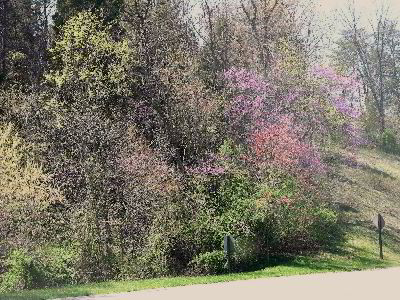
Spring blooms
Spring arrived in Virginia. Here were the first trees in full leaf.
Most were in peoples yards and may not be native to the area, but
they had green leaves. My goal for the night was Shenandoah National
Park, VA along the way of my journey to the ENTS Moot in Black
Mountain, NC starting tomorrow. There were a few old growth sites
described in Mary Byrd's "Old Growth in the East" within
the park, and I wanted to check some of them out. The Virginia
National Heritage Program described old growth in Limberlost (25
acres), Ivy Creek (15 acres), Mount Marshall (5 acres), Pocosin
Hollow and Entry Run (5 acres), with patches also at Stony Man.
Randy Winstead reported Upper Stauton River (15 acres) and Laurel
prong (no estimate). Bob Leverett would expand the White Oak Canyon
old growth another 25 acres to include some old growth hardwoods
down in the gorge.
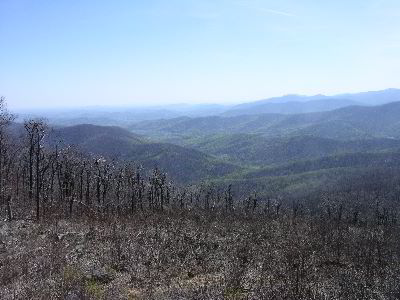
Ridge and Valley looking westward from Shenandoah National Park
The National Park service had reported there were three areas that
had old-growth hemlock at one time: Hemlock Springs, Limberlost, and
Camp Hoover. These had all been decimated by HWA killing al of the
old-growth hemlock in the park, and about 90% mortality for the
species in the park as a whole. I wanted to visit one of these areas
to see the dead forests. I hoped to be able to measure some standing
snags to see approximately how big they might have grown. The last
to succumb was the Limberlost area in the period from 2001-2003. As
I am still having problems with bronchitis and coughing, I decided
to focus on this area on today's trip, but that does not mean I did
not make some other stops.
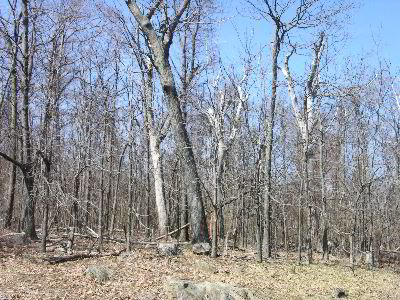
Dry old growth oak forest on Ridgetop, opposite Keyser Run Road
parking.
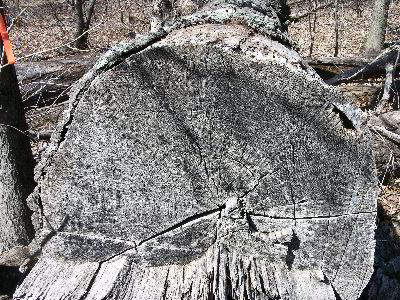
I counted 215 rings on this roadside stump of a red oak (Quercus
rubra)
I entered the park at Front Royal and headed south. Stopping at the
visitors center and talking to the Ranger there help confirm in my
mind that the Limberlost area was my best bet. The road through the
park is part of the Blue Ridge parkway and follows down the spine of
the mountain range across most of Virginia and into North Carolina.
The ridgetops are rocky and covered in forest. Some look to be
simply younger scraggly tree specimens that are trying to grow on
poor soil. Other areas however have bigger diameter trees that look
gnarled with age and have character. I wondered if these might be
old-growth patches. At the Keyser Run Road parking area I got my
chance to find out. There were several larger trees cut along the
roadside opposite the parking area. I pulled off and examined the
stumps. The two I looked at were red oak stumps. The first was 2'
3" in diameter and I counted approximately 142 rings. The
second stump was 2' 11" in diameter and I counted 214 rings on
this specimen. These were on the larger side of the trees in the
area, but certainly were not the largest present in the ridgetop
forest. All of them had the same basic physical characteristics with
gnarled and twisted trunks, and a lot of character. Much of the park
had been timbered prior to its establishment in 1935. I would
consider an area with a mixed aged stand of gnarled trees, some of
which exceed 200 years, and no evidence of previous logging, to be
old-growth forest. This initial patch extend for some distance along
the road, and there are numerous other patches with similar
characteristics along the parkway. It is my interpretation that
while these trees could have been cut, they were not because of
there stunted size and twisted character. There were better and more
profitable trees to cut farther down the slopes. I would like to see
an effort made to document these patches of old-growth forest. It
likely was not recognized in the initial Heritage survey because the
specimens are not large in size, even though they may be old. (It is
possible the area was cut a couple hundred years ago, be that
doesn't seem likely.) I believe there are may more acres of
old-growth forest in the park than are currently documented, and
that these areas should be managed as old-growth forest. Later
conversations with Bob Leverett served to confirm my opinion that
there are many acres of undocumented old growth atop the ridges of
the Skyline Drive and Blue Ridge Parkway. Old growth in the east
typically consists of pockets of non-commercial tree or trees that
were simply impractical to harvest because of their location.
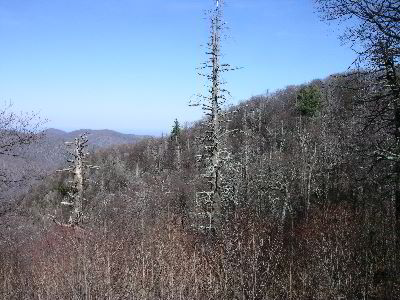
Dead Hemlock snags at Hemlock Springs Overlook
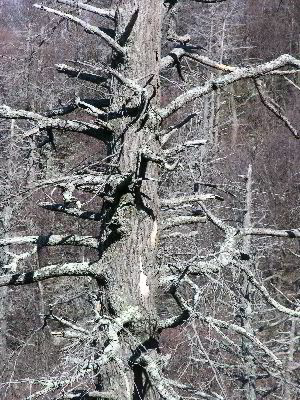
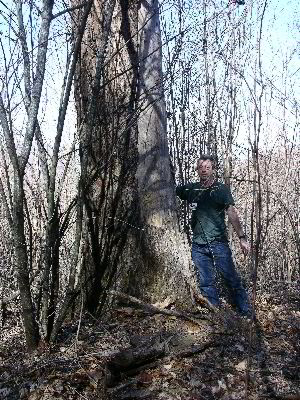
Base of the tallest of the two hemlock snags shown above at Hemlock
Springs Overlook
The next area I visited was the Hemlock Springs Overlook. A small
run extends from a spring and flows down a valley here. The
old-growth hemlock grew on the sides of the valley. From the
overlook the large numbers of dead hemlock trees can be seen. Most
have deteriorated, and have lost their tops and most of their
branches if they have not fallen. There are two fair sized dead
specimens in the immediate area of the overlook. One appears to be
relatively intact for height, perhaps upright branches are missing,
but the trunk itself seems to be all there, and a second specimen
with a broken top. The more intact of the two, and frankly the best
looking and tallest specimen I could see without severe bushwacking
tuned out to be 82.9 feet tall, and had a girth of 9' 10." The
second broken specimen was measured at 73.5 feet tall to the broken
top, and had a girth of 10' 10." The fallen top was too broken
up get a measurement of the fallen portion.
From here my next stop was at the Limberlost section. I parked at
the White Oak Canyon Trailhead and hiked down to the Limberlost
Trail. The Limberlost trail is a ADA accessible trail that runs for
a couple of miles in a loop. There are quite a few dead hemlocks
that have been cut-down and chopped up along the trail. Most are not
that old.
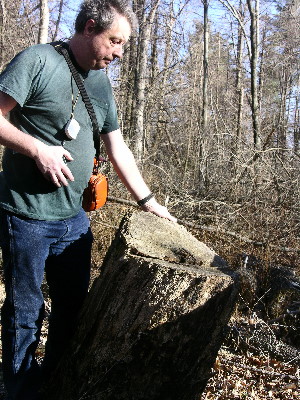 200+ year old hemlock stump
200+ year old hemlock stump
The first few stumps I counted were 98 years, 84 years,
115 years, and the majority of the stumps found were in this age
range. In the first section of the Limberlost Trail going clockwise
from the intersection with the white oak trail, I found only two
downed trees that were in excess of 200 years old. I have GPS
coordinates for everything. There were a few smaller living
hemlocks, but all of the bigger specimens were dead, and all of the
ones near the trail were cut down by park people as a safety hazard.
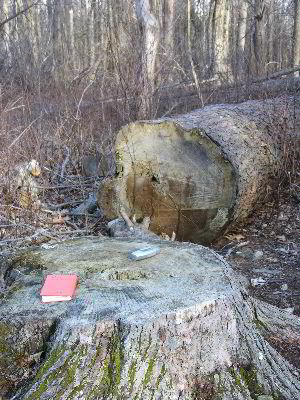
I counted 325 rings in this dead hemlock stump at Limberlost
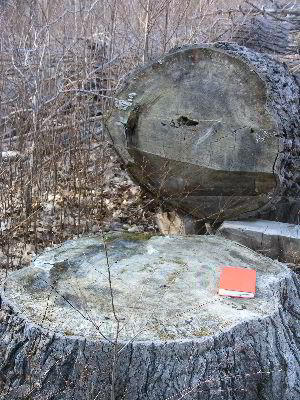
A second old hemlock stump in one area of Limberlost. This one is
47" in diameter.
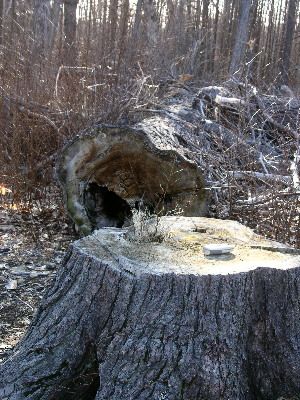
Third of three large hemlocks along Limberlost Trail
The prize (if you can call the corpses of the dead hemlocks a prize)
however was at the far side of the loop. Just past here the trail
crossed the Old Rag Fire Road were three very large and old downed
hemlocks within a few feet of each other. The first was 47" in
diameter, and likely over 300 years old. The second, 41" in
diameter, was on the opposite side (outside of the loop). I did a
rough count of 325 rings in this specimen and the trunk was solid to
the center. The third also was very old and 41" in diameter. A
sign at the start of the trail says this patch was set aside and
spared from the logging saws because of the magnificent 300 year old
specimens present. Now they are dead.
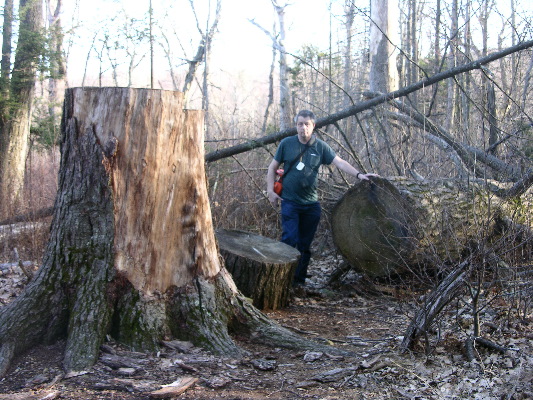
Hemlock at intersection of White Oak and Limberlost trail
In a letter in answer to my survey the park service wrote,
"Over the last 11 years, several droughts are believed to have
accelerated HWA-related hemlock mortality throughout the park (e.g.
two droughts between 2000 and 2002 were probable causes of the
previously healthy Limberlost old-growth (high elevation) stand for
having quickly succumbed to the HWA during 2001-2003)."
The trees at the site were not very tall. The tallest individual I
measured was a white pine at just under 90 feet. The white pines
were the only emergent from the canopy at around 70 to 75 feet.. I
doubt that the hemlocks, even the fattest and oldest were as tall as
the white pines. I did not get a measurement of the downed specimens
and do not know if they were even intact enough to measure their
height.
These were not the first hemlock forests to die, and unfortunately
they will not be the last. At the time of the demise of these
hemlocks the most effective systemic insecticide had not been
released yet and was not available for treating these trees. Even
with imidacloprid, there are some deaths with trees already too far
gone to save. I do think the NPS missed the boat by not trying any
of a number of other chemical treatment options that may have kept
the trees alive long enough for longer term options to be
considered.
I would like to encourage the NPS to collect some of these fantastic
hemlock cookies, literally a hundred feet from a road, to display in
their visitors center, and perhaps so that a future
dendrochronologist could look at the fire and climate history of the
region. There was a set of cross-dated cores taken from trees in
this area in the 90's that could be used for correlating with the
tree cookies. I was coughing badly by the time I finished the loop,
so I headed for a campsite and called it a day. I stayed at the
Lewis Mountain campsite. It was lightly populated this time of the
year and a pleasant looking campground. I went to bed early.
Edward Frank, April 19, 2008
== 3 of 3 ==
Date: Mon, Apr 21 2008 7:55 pm
From: James Parton
Ed,
Nice pics and report. I remember you showing me the full-sized
pictures at the " moot ". It is a real shame that
Shenandoah has been
decimated by the adelgid.
JP
==============================================================================
TOPIC: Shenandoah National Park, VA - April 19, 2008
http://groups.google.com/group/entstrees/browse_thread/thread/490235cd0f21d83d?hl=en
==============================================================================
== 1 of 1 ==
Date: Tues, Apr 22 2008 3:37 pm
From: Matthew Hannum
My brother and I went through Shenandoah back in June of 2004. At
the
time, I was not yet aware of the hemlock situation, though many of
the
trees were already dead at that point. A terrible loss, especially
judging by their age and numbers. There's just too many exotic pests
out there: emerald ash borer, the adelgid, beech bark disease, etc.
Shenandoah is a beautiful place, and at least we can be thankful it
was turned into a park and allowed to regrow. I just hope humanity
doesn't destroy it again with introduced pests and diseases.
|